air condition TOYOTA GR86 2022 Owners Manual (in English)
[x] Cancel search | Manufacturer: TOYOTA, Model Year: 2022, Model line: GR86, Model: TOYOTA GR86 2022Pages: 582, PDF Size: 86.38 MB
Page 3 of 582
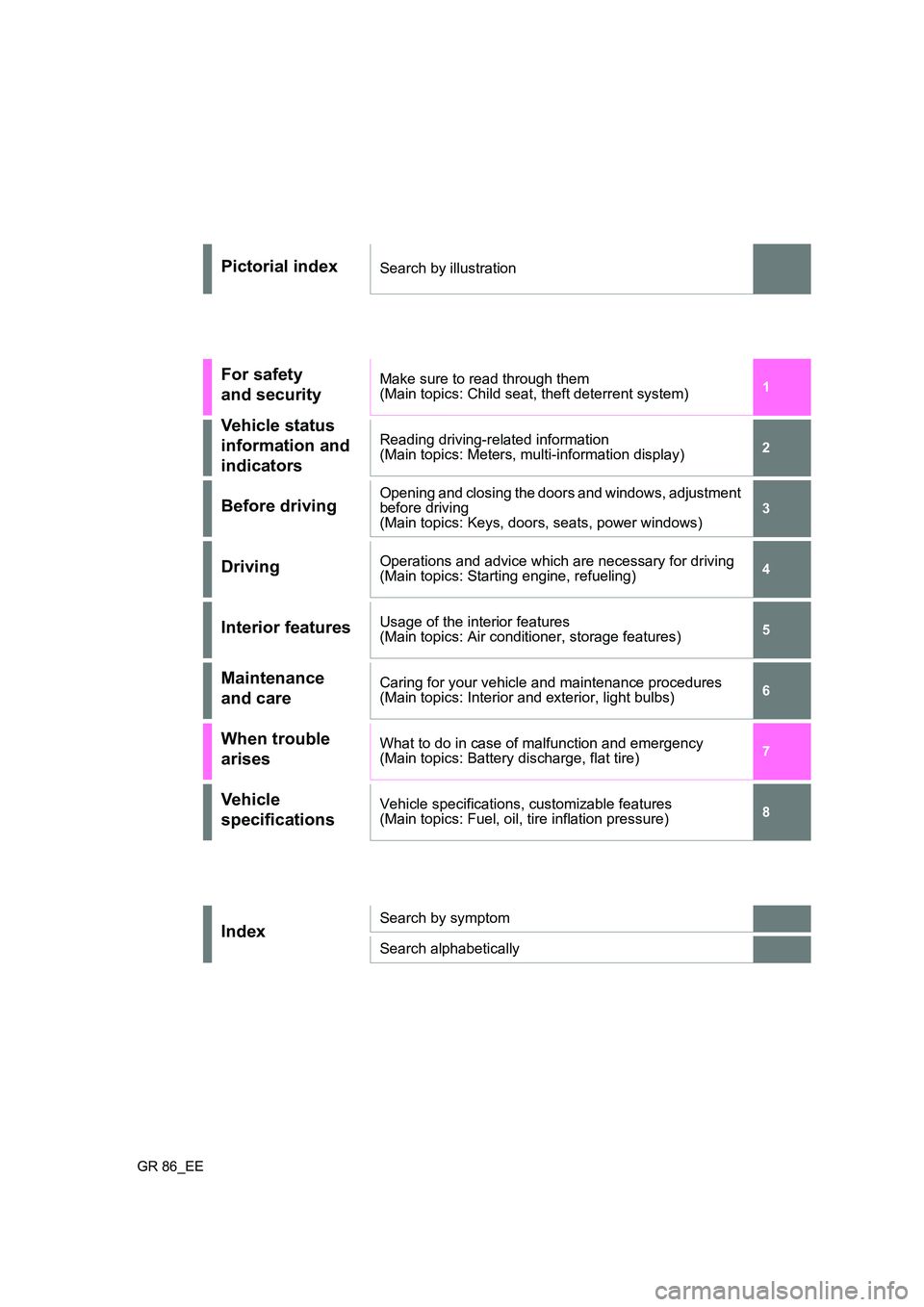
GR 86_EE
1
6
5
4
3
2
8
7
Pictorial indexSearch by illustration
For safety
and security
Make sure to read through them (Main topics: Child seat, theft deterrent system)
Vehicle status
information and
indicators
Reading driving-related information (Main topics: Meters, multi-information display)
Before drivingOpening and closing the doors and windows, adjustment before driving (Main topics: Keys, doors, seats, power windows)
DrivingOperations and advice which are necessary for driving (Main topics: Starting engine, refueling)
Interior featuresUsage of the interior features(Main topics: Air conditioner, storage features)
Maintenance
and care
Caring for your vehicle and maintenance procedures (Main topics: Interior and exterior, light bulbs)
When trouble
arises
What to do in case of malfunction and emergency (Main topics: Battery discharge, flat tire)
Ve h i c l e
specifications
Vehicle specifications, customizable features (Main topics: Fuel, oil, tire inflation pressure)
IndexSearch by symptom
Search alphabetically
Page 5 of 582
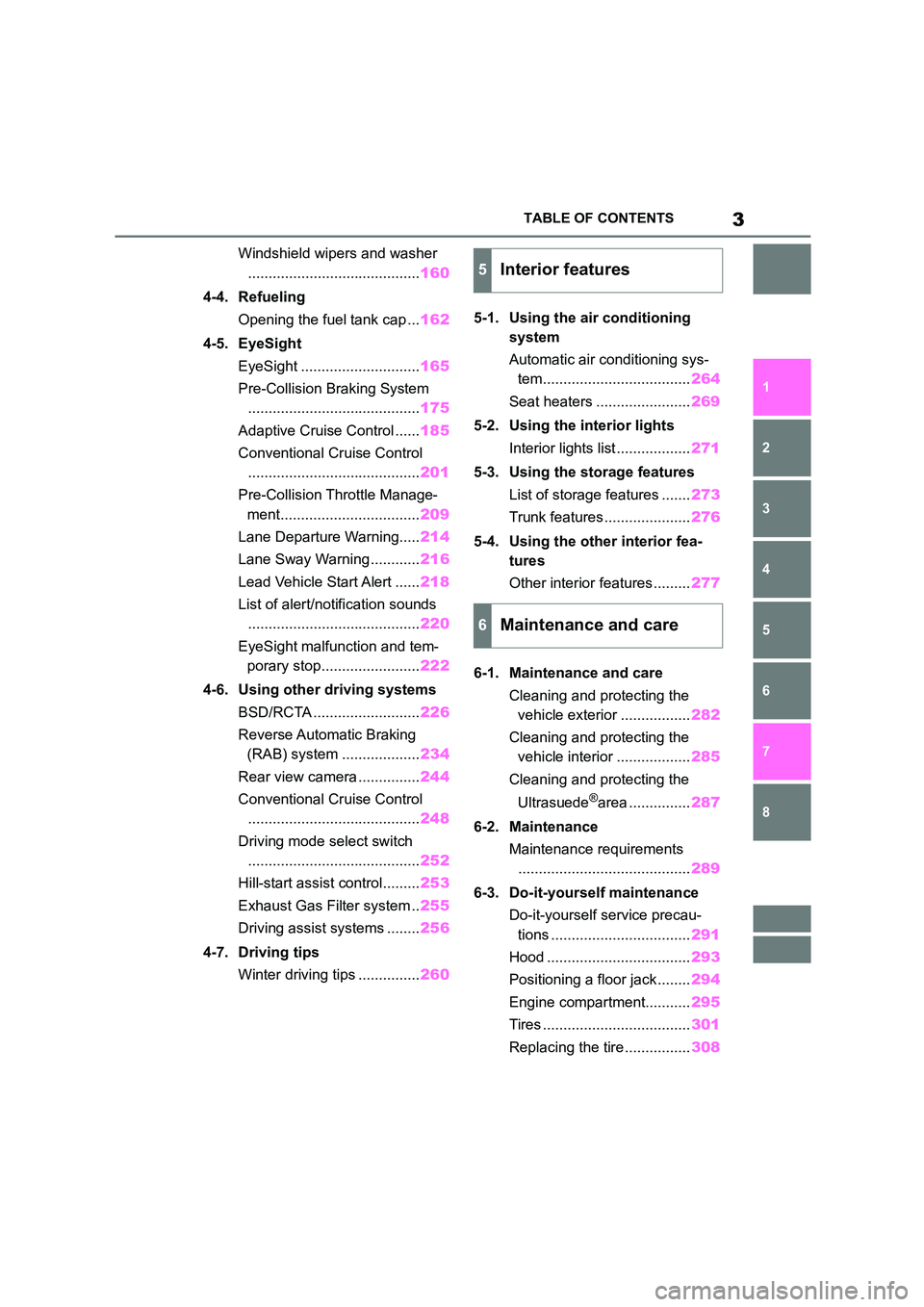
3TABLE OF CONTENTS
1
6
5
4
3
2
8
7
Windshield wipers and washer
.......................................... 160
4-4. Refueling
Opening the fuel tank cap ... 162
4-5. EyeSight
EyeSight ............................. 165
Pre-Collision Braking System
.......................................... 175
Adaptive Cruise Control ...... 185
Conventional Cruise Control
.......................................... 201
Pre-Collision Throttle Manage-
ment.................................. 209
Lane Departure Warning..... 214
Lane Sway Warning ............ 216
Lead Vehicle Start Alert ...... 218
List of alert/notification sounds
.......................................... 220
EyeSight malfunction and tem-
porary stop........................ 222
4-6. Using other driving systems
BSD/RCTA .......................... 226
Reverse Automatic Braking
(RAB) system ................... 234
Rear view camera ............... 244
Conventional Cruise Control
.......................................... 248
Driving mode select switch
.......................................... 252
Hill-start assist control......... 253
Exhaust Gas Filter system .. 255
Driving assist systems ........ 256
4-7. Driving tips
Winter driving tips ............... 260
5-1. Using the air conditioning
system
Automatic air conditioning sys-
tem.................................... 264
Seat heaters ....................... 269
5-2. Using the interior lights
Interior lights list .................. 271
5-3. Using the storage features
List of storage features ....... 273
Trunk features..................... 276
5-4. Using the other interior fea-
tures
Other interior features ......... 277
6-1. Maintenance and care
Cleaning and protecting the
vehicle exterior ................. 282
Cleaning and protecting the
vehicle interior .................. 285
Cleaning and protecting the
Ultrasuede®area ............... 287
6-2. Maintenance
Maintenance requirements
.......................................... 289
6-3. Do-it-yourself maintenance
Do-it-yourself service precau-
tions .................................. 291
Hood ................................... 293
Positioning a floor jack ........ 294
Engine compartment........... 295
Tires .................................... 301
Replacing the tire ................ 308
5Interior features
6Maintenance and care
Page 6 of 582

4TABLE OF CONTENTS
Tire inflation pressure .........312
Wheels ................................ 313
Air conditioning filter ........... 314
Electronic key battery ......... 316
Checking and replacing fuses
.......................................... 319
Light bulbs .......................... 321
7-1. Essential information
Emergency flashers ............ 326
If your vehicle has to be stopped
in an emergency ............... 326
If the vehicle is submerged or
water on the road is rising
.......................................... 327
7-2. Steps to take in an emergency
If your vehicle needs to be towed
.......................................... 329
If you think something is wrong
.......................................... 334
Fuel pump shut off system
.......................................... 335
If a warning light turns on or a
warning buzzer sounds ..... 336
If a warning message is dis-
played ............................... 344
If you have a flat tire ........... 345
If the engine will not start .... 355
If you lose your keys ........... 356
If the fuel filler door cannot be
opened.............................. 357
If the electronic key does not
operate properly ............... 357
If the vehicle battery is dis-
charged............................. 359
If your vehicle overheats ..... 362
If the vehicle becomes stuck
.......................................... 364
8-1. Specifications
Maintenance data (fuel, oil level,
etc.)................................... 368
Fuel information .................. 376
8-2. Customization
Customizable features ........ 377
What to do if... (Troubleshooting)
.......................................... 386
Alphabetical Index .............. 389
7When trouble arises
8Vehicle specifications
Index
Page 9 of 582

7
ing on the severity and type of a
crash.
The EDR in this vehicle is designed
to record such data as:
• How various systems in your
vehicle were operating;
• How far (if at all) the driver was
depressing the accelerator
and/or brake pedal; and,
• How fast the vehicle was
traveling.
These data can help provide a bet-
ter understanding of the circum-
stances in which crashes and
injuries occur.
NOTE: EDR data are recorded by
your vehicle only if a non-trivial
crash situation occurs; no data are
recorded by the EDR under normal
driving conditions and no personal
data (e.g., name, gender, age, and
crash location) are recorded. How-
ever, other parties, such as law
enforcement, could combine the
EDR data with the type of person-
ally identifying data routinely
acquired during a crash investiga-
tion.
To read data recorded by an EDR,
special equipment is required, and
access to the vehicle or the EDR is
needed. In addition to the vehicle
manufacturer, other parties, such
as law enforcement, that have the
special equipment, can read the
information if they have access to
the vehicle or the EDR.
Disclosure of the EDR data
Toyota will not disclose the data
recorded in an EDR to a third party
except when:
• An agreement from the vehicle’s
owner (or the lessee for a leased
vehicle) is obtained
• In response to an official request by
the police, a court of law or a govern-
ment agency
• For use by Toyota in a lawsuit
However, if necessary, Toyota may:
• Use the data for research on vehicle
safety performance
• Disclose the data to a third party for
research purposes without disclos-
ing information about the specific
vehicle or vehicle owner
The SRS airbag and seat belt
pretensioner devices in your Toyota
contain explosive c hemicals. If the
vehicle is scrapped with the airbags
and seat belt pretensioners left as
they are, this may cause an acci-
dent such as fire. Be sure to have
the systems of the SRS airbag and
seat belt pretensioner removed and
disposed of by a qualified service
shop or by any authorized Toyota
retailer or Toyota authorized
repairer, or any reliable repairer
before you scrap your vehicle.
The word “QR Code” is registered
trademark of DENSO WAVE
INCORPORATED in Japan and
other countries.
Scrapping of your Toyota
“QR Code”
Page 16 of 582

14Pictorial index
Parking brake .................................................................................P.151
Applying/releasing............................................................................P.151
Precautions for winter season..........................................................P.261
Warning lights ..................................................................................P.336
Headlight switch ...........................................................................P.153
Turn signal lever ............................................................................P.150
Headlights/front position lights/tail lights/daytime running lights ......P.153
Rear fog light....................................................................................P.159
Windshield wiper and washer switch ..........................................P.160
Usage...............................................................................................P.160
Adding washer fluid..........................................................................P.300
Headlight cleaners ...........................................................................P.160
Emergency flasher switch.............................................................P.326
Hood lock release lever .................................................................P.293
Tilt and telescopic steering lock release lever ............................P.122
Adjustment .......................................................................................P.122
Air conditioning system ................................................................P.264
Usage...............................................................................................P.264
Rear window defogger .....................................................................P.266
Audio system*2
*1: Vehicles with an automatic transmission
*2: Refer to “Multimedia owner’s manual”.
Page 22 of 582
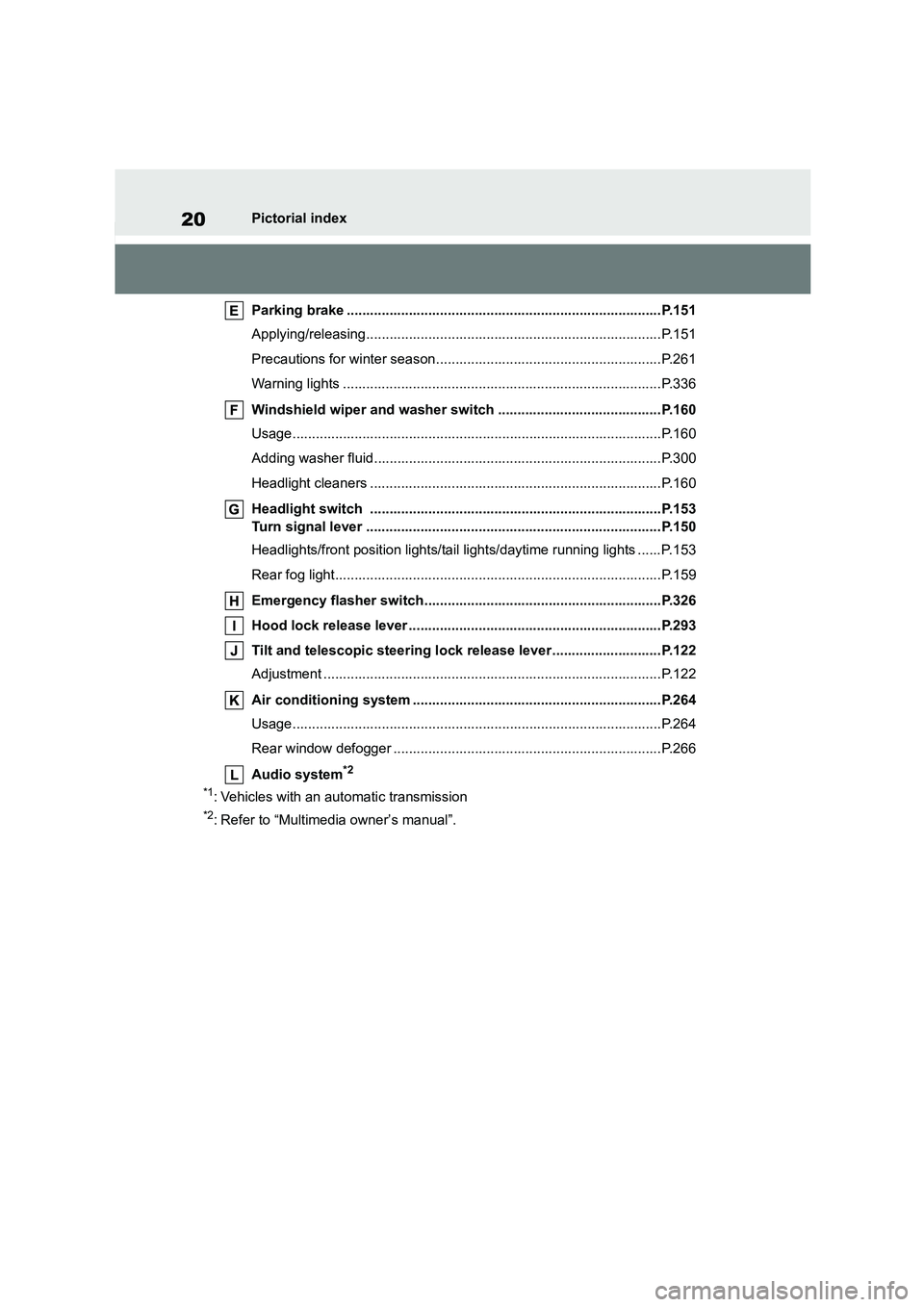
20Pictorial index
Parking brake .................................................................................P.151
Applying/releasing............................................................................P.151
Precautions for winter season..........................................................P.261
Warning lights ..................................................................................P.336
Windshield wiper and washer switch ..........................................P.160
Usage...............................................................................................P.160
Adding washer fluid..........................................................................P.300
Headlight cleaners ...........................................................................P.160
Headlight switch ...........................................................................P.153
Turn signal lever ............................................................................P.150
Headlights/front position lights/tail lights/daytime running lights ......P.153
Rear fog light....................................................................................P.159
Emergency flasher switch.............................................................P.326
Hood lock release lever .................................................................P.293
Tilt and telescopic steering lock release lever ............................P.122
Adjustment .......................................................................................P.122
Air conditioning system ................................................................P.264
Usage...............................................................................................P.264
Rear window defogger .....................................................................P.266
Audio system*2
*1: Vehicles with an automatic transmission
*2: Refer to “Multimedia owner’s manual”.
Page 48 of 582
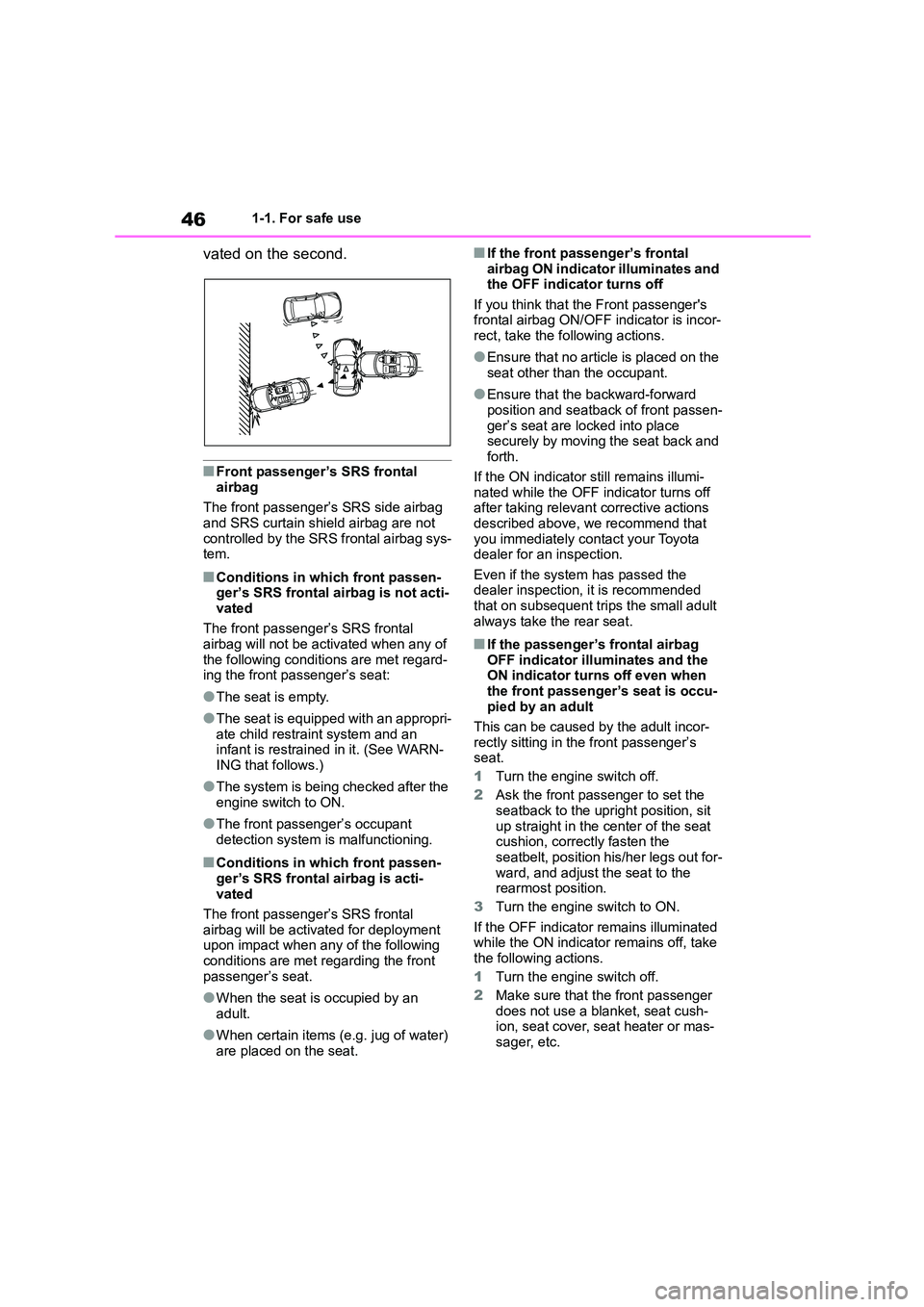
461-1. For safe use
vated on the second.
■Front passenger’s SRS frontal
airbag
The front passenger’s SRS side airbag and SRS curtain shield airbag are not
controlled by the SRS frontal airbag sys-
tem.
■Conditions in which front passen- ger’s SRS frontal ai rbag is not acti-
vated
The front passenger’s SRS frontal airbag will not be activated when any of
the following conditions are met regard-
ing the front passenger’s seat:
●The seat is empty.
●The seat is equipped with an appropri-
ate child restra int system and an
infant is restrained in it. (See WARN- ING that follows.)
●The system is being checked after the engine switch to ON.
●The front passenger’s occupant detection system is malfunctioning.
■Conditions in which front passen-
ger’s SRS frontal airbag is acti-
vated
The front passenger’s SRS frontal airbag will be activated for deployment
upon impact when any of the following
conditions are met regarding the front passenger’s seat.
●When the seat is occupied by an adult.
●When certain items (e.g. jug of water) are placed on the seat.
■If the front passenger’s frontal
airbag ON indicator illuminates and the OFF indicator turns off
If you think that the Front passenger's
frontal airbag ON/OFF indicator is incor- rect, take the following actions.
●Ensure that no article is placed on the seat other than the occupant.
●Ensure that the backward-forward position and seatback of front passen-
ger’s seat are locked into place
securely by moving the seat back and forth.
If the ON indicator still remains illumi-
nated while the OFF indicator turns off after taking relevant corrective actions
described above, we recommend that
you immediately contact your Toyota dealer for an inspection.
Even if the system has passed the
dealer inspection, it is recommended that on subsequent trips the small adult
always take the rear seat.
■If the passenger’s frontal airbag
OFF indicator illuminates and the ON indicator turn s off even when
the front passenger’s seat is occu-
pied by an adult
This can be caused by the adult incor-
rectly sitting in the front passenger’s
seat.
1 Turn the engine switch off.
2 Ask the front passenger to set the seatback to the upright position, sit
up straight in the center of the seat
cushion, correctly fasten the seatbelt, position his/her legs out for-
ward, and adjust the seat to the
rearmost position.
3 Turn the engine switch to ON.
If the OFF indicator remains illuminated while the ON indicator remains off, take
the following actions.
1 Turn the engine switch off.
2 Make sure that the front passenger
does not use a blanket, seat cush- ion, seat cover, seat heater or mas-
sager, etc.
Page 56 of 582
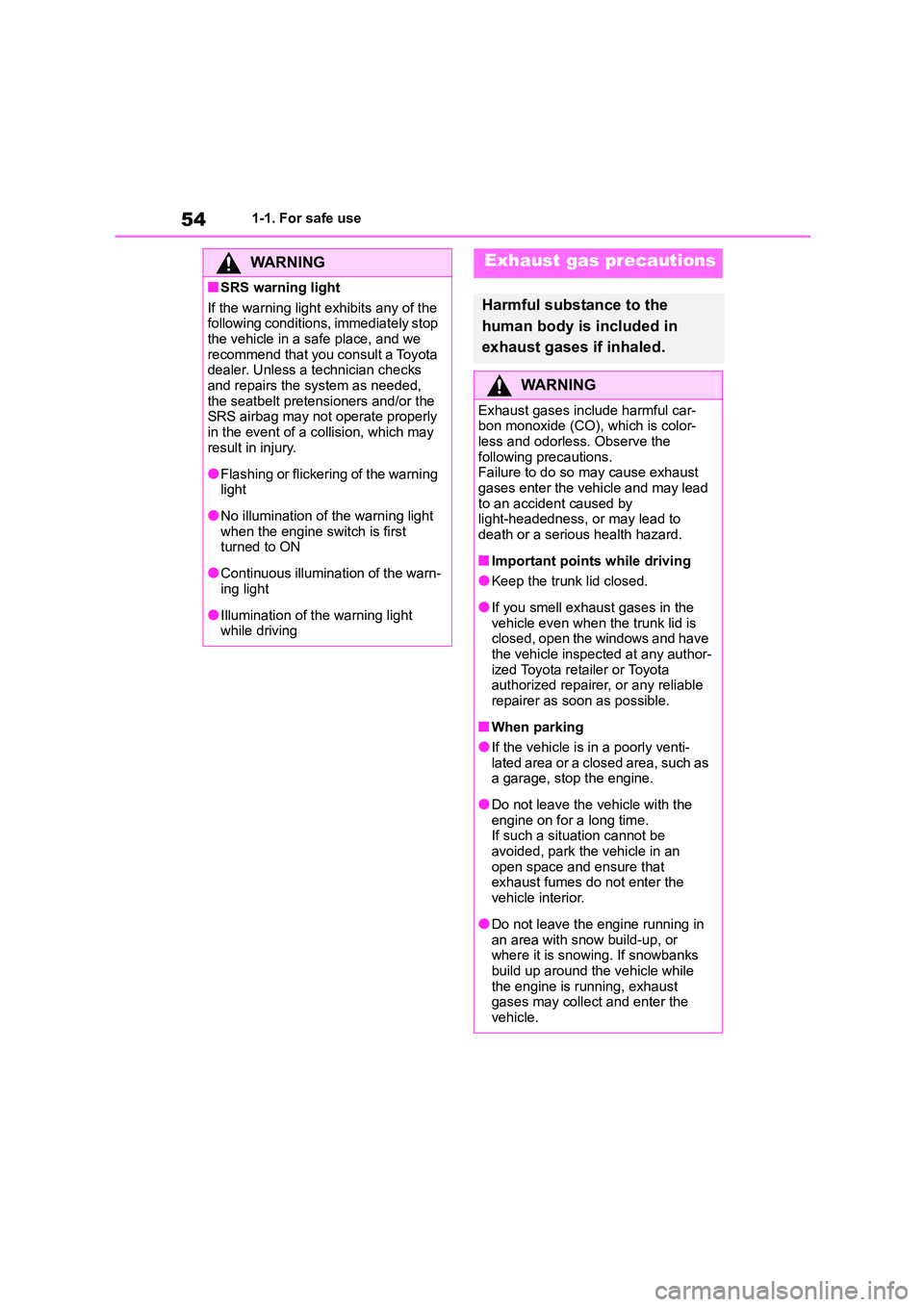
541-1. For safe use
WA R N I N G
■SRS warning light
If the warning light exhibits any of the
following conditions, immediately stop the vehicle in a safe place, and we
recommend that you consult a Toyota
dealer. Unless a technician checks and repairs the system as needed,
the seatbelt pretensioners and/or the
SRS airbag may not operate properly
in the event of a collision, which may result in injury.
●Flashing or flickering of the warning light
●No illumination of the warning light when the engine switch is first
turned to ON
●Continuous illumination of the warn-
ing light
●Illumination of the warning light
while driving
Exhaust gas precautions
Harmful substance to the
human body is included in
exhaust gases if inhaled.
WA R N I N G
Exhaust gases include harmful car-
bon monoxide (CO), which is color-
less and odorless. Observe the following precautions.
Failure to do so may cause exhaust
gases enter the vehicle and may lead to an accident caused by
light-headedness, or may lead to
death or a serious health hazard.
■Important points while driving
●Keep the trunk lid closed.
●If you smell exhaust gases in the
vehicle even when the trunk lid is closed, open the windows and have
the vehicle inspected at any author-
ized Toyota retailer or Toyota authorized repairer, or any reliable
repairer as soon as possible.
■When parking
●If the vehicle is in a poorly venti-
lated area or a closed area, such as a garage, stop the engine.
●Do not leave the vehicle with the engine on for a long time.
If such a situation cannot be
avoided, park the vehicle in an open space and ensure that
exhaust fumes do not enter the
vehicle interior.
●Do not leave the engine running in
an area with snow build-up, or where it is snowing. If snowbanks
build up around the vehicle while
the engine is running, exhaust gases may collect and enter the
vehicle.
Page 113 of 582
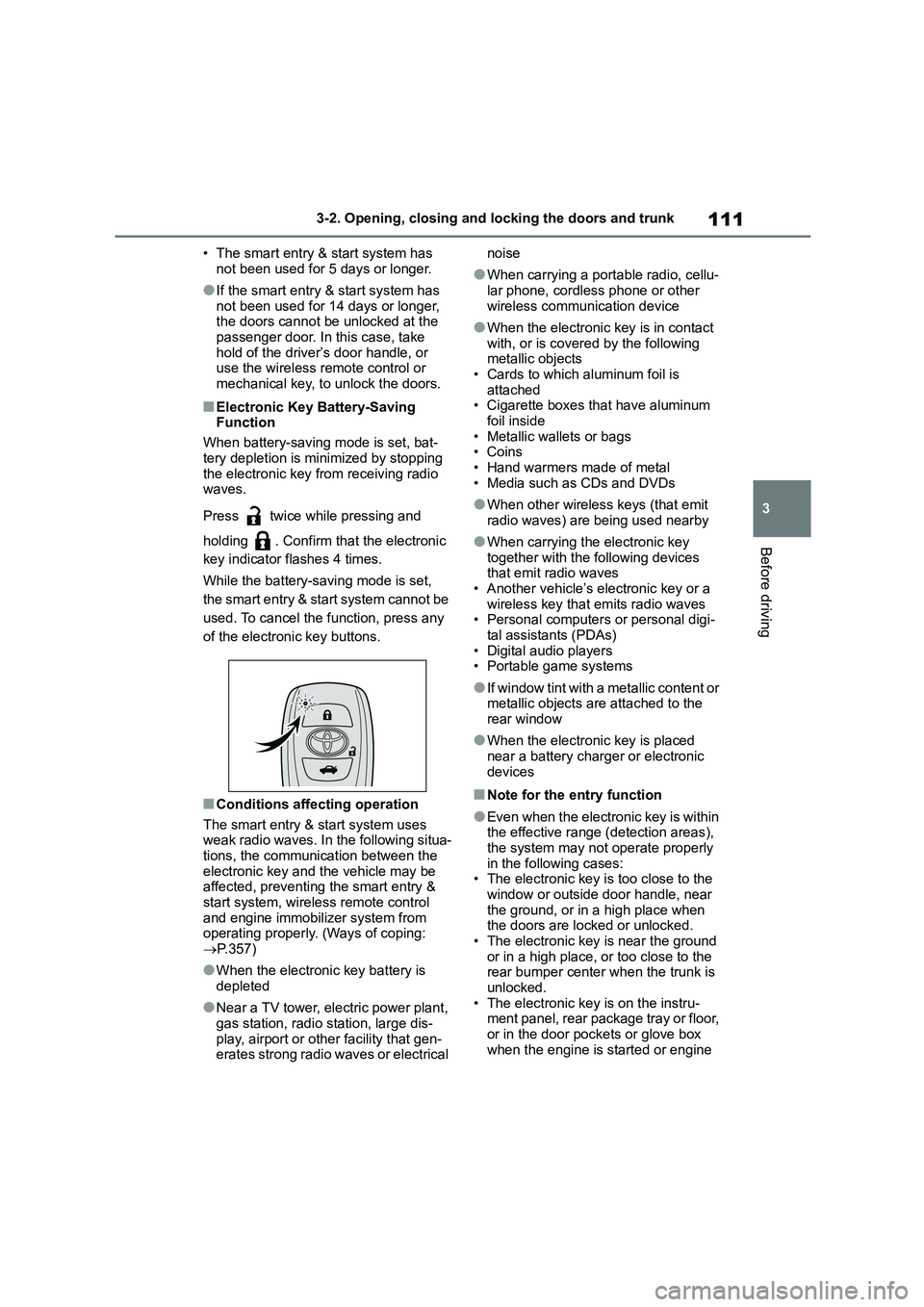
111
3
3-2. Opening, closing and locking the doors and trunk
Before driving
• The smart entry & start system has
not been used for 5 days or longer.
●If the smart entry & start system has
not been used for 14 days or longer, the doors cannot be unlocked at the
passenger door. In this case, take
hold of the driver’s door handle, or use the wireless remote control or
mechanical key, to unlock the doors.
■Electronic Key Battery-Saving
Function
When battery-saving mode is set, bat-
tery depletion is minimized by stopping
the electronic key from receiving radio waves.
Press twice while pressing and
holding . Confirm that the electronic
key indicator flashes 4 times.
While the battery-saving mode is set,
the smart entry & start system cannot be
used. To cancel the function, press any
of the electronic key buttons.
■Conditions affecting operation
The smart entry & start system uses
weak radio waves. In the following situa- tions, the communication between the
electronic key and the vehicle may be
affected, preventing the smart entry &
start system, wireless remote control and engine immobilizer system from
operating properly. (Ways of coping:
P.357)
●When the electronic key battery is
depleted
●Near a TV tower, electric power plant,
gas station, radio station, large dis- play, airport or other facility that gen-
erates strong radio waves or electrical
noise
●When carrying a portable radio, cellu-
lar phone, cordless phone or other
wireless communication device
●When the electronic key is in contact
with, or is covered by the following metallic objects
• Cards to which aluminum foil is
attached • Cigarette boxes that have aluminum
foil inside
• Metallic wallets or bags •Coins
• Hand warmers made of metal
• Media such as CDs and DVDs
●When other wirele ss keys (that emit
radio waves) are being used nearby
●When carrying the electronic key
together with the following devices that emit radio waves
• Another vehicle’s electronic key or a
wireless key that emits radio waves • Personal computers or personal digi-
tal assistants (PDAs)
• Digital audio players • Portable game systems
●If window tint with a metallic content or metallic objects are attached to the
rear window
●When the electronic key is placed
near a battery charger or electronic
devices
■Note for the entry function
●Even when the electronic key is within
the effective range (detection areas), the system may not operate properly
in the following cases:
• The electronic key is too close to the window or outside door handle, near
the ground, or in a high place when
the doors are locked or unlocked.
• The electronic key is near the ground or in a high place, or too close to the
rear bumper center when the trunk is
unlocked. • The electronic key is on the instru-
ment panel, rear package tray or floor,
or in the door pockets or glove box when the engine is started or engine
Page 115 of 582
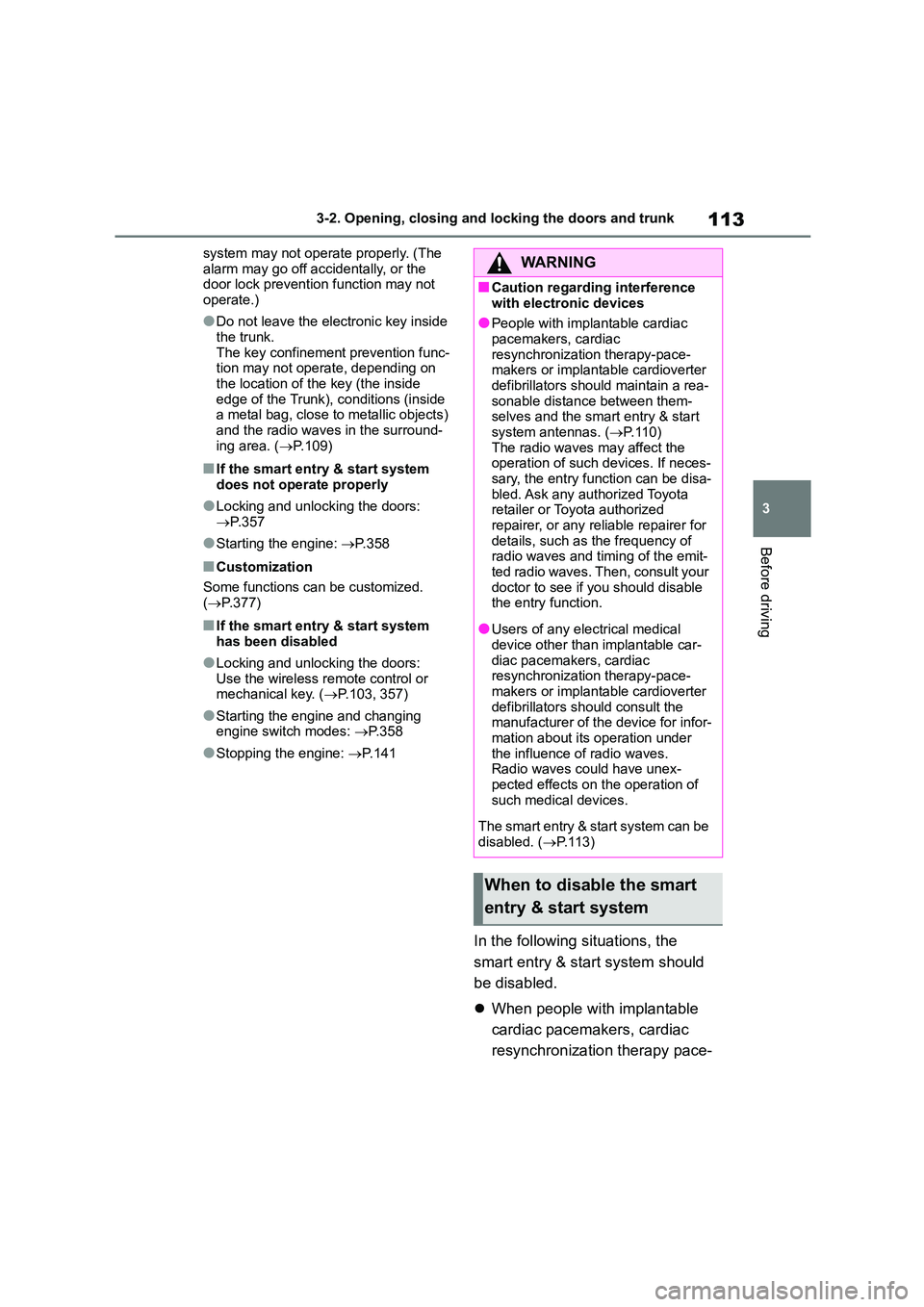
113
3
3-2. Opening, closing and locking the doors and trunk
Before driving
system may not operat e properly. (The
alarm may go off accidentally, or the door lock prevention function may not
operate.)
●Do not leave the electronic key inside
the trunk.
The key confinement prevention func- tion may not operate, depending on
the location of the key (the inside
edge of the Trunk), conditions (inside a metal bag, close to metallic objects)
and the radio waves in the surround-
ing area. ( P.109)
■If the smart entry & start system does not operate properly
●Locking and unlocking the doors: P. 3 5 7
●Starting the engine: P. 3 5 8
■Customization
Some functions can be customized.
( P.377)
■If the smart entry & start system
has been disabled
●Locking and unlocking the doors:
Use the wireless remote control or mechanical key. ( P.103, 357)
●Starting the engine and changing engine switch modes: P. 3 5 8
●Stopping the engine: P. 1 4 1
In the following situations, the
smart entry & start system should
be disabled.
When people with implantable
cardiac pacemakers, cardiac
resynchronization therapy pace-
WA R N I N G
■Caution regarding interference
with electronic devices
●People with implantable cardiac pacemakers, cardiac
resynchronization therapy-pace-
makers or implantable cardioverter defibrillators should maintain a rea-
sonable distance between them-
selves and the smart entry & start
system antennas. ( P.110) The radio waves may affect the
operation of such devices. If neces-
sary, the entry function can be disa- bled. Ask any authorized Toyota
retailer or Toyota authorized
repairer, or any reliable repairer for details, such as the frequency of
radio waves and timing of the emit-
ted radio waves. Then, consult your doctor to see if you should disable
the entry function.
●Users of any electrical medical
device other than implantable car-
diac pacemakers, cardiac resynchronization therapy-pace-
makers or implantable cardioverter
defibrillators should consult the manufacturer of the device for infor-
mation about its operation under
the influence of radio waves. Radio waves could have unex-
pected effects on the operation of
such medical devices.
The smart entry & start system can be
disabled. ( P.113)
When to disable the smart
entry & start system